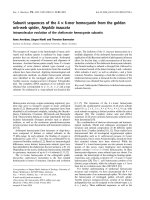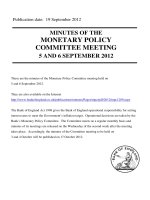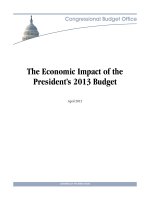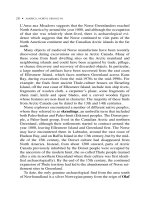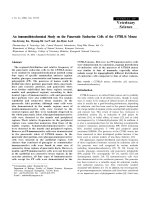Approved-Minutes-of-the-November-6-2013-LIOB-Meeting
Bạn đang xem bản rút gọn của tài liệu. Xem và tải ngay bản đầy đủ của tài liệu tại đây (100.39 KB, 8 trang )
Low Income Oversight Board (LIOB)
November 6, 2013
San Diego County Operations Center Conference Ctr. Hearing Room
5520 Overland Ave.
San Diego, CA 92123
10am - 3pm
www.liob.org
Call - In Number 1-877-930 0524 - Passcode 3494395#
Approved Meeting Minutes
LIOB Board Members Present:
Chairman Jose Atilio Hernandez, Vice-Chairwoman Patricia Watts, Commissioner Catherine J.K. Sandoval,
Jason Wimbley, Ortensia Lopez, Dave Stephenson, Janine Scancarelli, , Alex Kim and Larry Gross (quorum
present)
LIOB Members Absent: Charlie Toledo and Jason A. Hobson
California Public Utilities Commission (CPUC) Staff Present:
Syreeta Gibbs and Zaida Amaya
Public Present:
Steve Hruby, Richard Villasenor, Lydia Flores, Mark Aguirre, Emma Ponco, Robert Castañeda, Mary
O’Drain, Frances Thompson, Nickole Prodouz, Dave Canny, Paul Giles, David Ortiz, Dave Clark, Jackie
Carreon, Michael Grimaud, Sandra Williams, Yvette Vasquez, Kiandra Andrews, Brenda Gettig, Pamela
Wu, Arleen Novotney, Allen Fernandez Smith and Anna Solorio
Participants Via Conference:
Benjamin Schein, Joy Yamagata, Patti Landry, Carol Edwards & Hugh Yao
Meeting called to order by Chairman Hernandez at 10:10am.
Item 1. Welcome and Introductions— Jose Hernandez, LIOB Chair and Commissioner Catherine J.K.
Sandoval (10 minutes) Standing Item
Chairman Hernandez and Commissioner Sandoval welcomed everyone to the final LIOB meeting of 2013.
Chairman Hernandez thanked staff, the utilities, contractors and stakeholders for their work during 2013
and indicated that, there is still more work to be done but the board looks forward to a very successful
2014.
Commissioner Sandoval thanked the San Diego Operations Center staff for their hospitality. She stated
that meeting throughout California offers the LIOB the opportunity to meet constituents and hear about
their work, concerns, issues and successes.
Item 2. Public comments— Facilitated by Jose Hernandez, LIOB Chair (15 minutes)
Informational/Standing item
Ms. Jackie Carreon from the National Asian American Coalition (NAAC) informed the board that there are
approximately three million low income constituents that are left out of CARE and other energy
conservation programs in San Diego. The reason for this is because California is using an outdated and
inaccurate poverty index. NAAC has written to the Legislator to request new legislation that will help
expand the number of persons eligible for CARE and other programs. NAAC urges the use of the index
developed by the University of Washington that takes into account differences across the country and
LIOB Meeting Minutes 11-6-13
Page 1
the cost of housing. As a recipient of the CARE program herself, Ms. Carreon knows the importance of
these programs. Ms. Faith Bautista, the CEO of NAAC requests the support of the LIOB and looks
forward to working with the Board, the utilities, the Commission and particularly with Commissioner
Sandoval on a definition of poverty that works for all Californian’s.
The Board thanked Ms. Carreon for her comments. Commissioner Sandoval encouraged Ms. Carreon to
file NAAC’s comments with the Commission in order to incorporate them into the record.
Mr. Robert Castañeda from Proteus, Inc. commented on the Energy Education Study, noting that there is
room for improvement, although the report shows progress. Proteus encourages uniformity and
statewide standardization for energy education, and encourages a close working relationship with
community based organizations in order to reach all cultures in different languages and informing
communities of the programs and benefits of energy efficiency.
Commissioner Sandoval stated that she had an opportunity to visit Proteus in Visalia and was extremely
impressed by their effectiveness and commitment to the community. She encouraged fellow board
members and anyone interested to also visit the facility.
Chairman Hernandez added that this is an item the Workforce Education and Training subcommittee will
be focusing on.
Item 3. Approval of the August 21, 2013 LIOB Meeting Minutes, Facilitated by Jose Hernandez, LIOB
Chair (5 minutes) Action Item
A motion was made to approve the August 21, 2013 LIOB minutes with a minor correction on pg. 5 as
noted by Commissioner Sandoval. The motion moved by Board Member Lopez and seconded by Board
Member Gross (Motion passed unanimously).
Item 4. Highlights of Upcoming Activities for Low-Income Energy Programs – Energy Division Staff (15
minutes) Standing Item
Ms. Gibbs provided an update on the highlights and upcoming activities for low-income energy
programs. Ms. Gibbs’ report can be viewed and downloaded at:
/>Item 5. Utilities’ Reports— Utility Representative (30 minutes) Standing /Action/Discussion Item
a) Update on IOU’s Studies Reports
i.
Multi-family Segment Study – PG&E
ii.
Impact Evaluation – SDG&E
iii.
Energy Education Study - SCE
iv.
Needs Assessment Study – SCE
Mary O’Drain of PG&E informed the Board that the ESA Program Energy Education Study and the ESA
PY2011 Impact Evaluation have been completed. The Multi-Family Study and the Low-Income Needs
Assessment study are currently in draft phase. Copies of the completed studies and draft studies can be
accessed thru www.energydataweb.com
Carol Edwards of SCE provided an overview of the Energy Education Study. The energy education study
found customers react and understand the content better during an interactive walk-thru of their home
and confirmed that there is no formal energy education during the CARE enrollment process.
LIOB Meeting Minutes 11-6-13
Page 2
Member Wimbley asked if the study looked at the opportunities for education that can be delivered on
the CARE side that can either complement or reinforce the current training. Ms. O’Drain explained that
they didn’t formally look at CARE during this process; however, she agreed that there are opportunities
for education and PG&E has been looking for other ways to reach out and educate customers, but that
the study looked specifically at the energy education as a component of ESA.
Vice Chairwoman Watts commented that if a home does not qualify under the 3 measure rule, there is
no incentive for the contractor to continue with the customer education and that this may be a
disservice to those customers who are interested in energy education. Ms. Edwards confirmed that
under the 3 measure minimum rule, the contractor is not compensated and cannot perform the energy
education.
Brenda Gettig of SDG&E provided an overview of the ESA Impact Evaluation Study. The study looked
backed in time to measure the savings that resulted from the ESA program treatments during the
program year 2011; the study was completed in August 2013. The purpose of the study was to produce
savings estimates for electricity and gas for the measures that were installed in the program. SDG&E
hired Evergreen Economics to conduct the study. A fixed effects billing regression model was used to
develop energy savings estimates (both KWh and therms) at the measure level for each IOU. The billing
regression model relied on weather data and monthly energy consumption data for both gas and
electricity. All of this information was supplied by the IOUs. A phone survey was conducted on a sample
of 600 participants that exhibited an increase in electricity usage directly after program participation.
The goal of this survey was to collect information on customer behavior that would help understand why
energy use was increasing. The study showed that despite the new measures and energy education
received through the program, a significant number of households were found to be consuming more
energy after participation. The phone survey did not provide any additional information as to what
might be causing this increase in energy use and in many instances the customer was not aware that
their consumption had increased.
Commissioner Sandoval asked if this study conducted bill analysis to see if the bills remained steady or if
it decreased because of the CARE discount.
Ms. Gettig stated that this was not part of the Impact Evaluation Study; as it was looking only at
consumption and not bills.
The utilities study report presentation can be viewed and downloaded at:
/>%20Final.ppt
b) Current Penetration Rates for CARE & ESAP
The penetration rates thru September 30, 2013 for CARE & ESAP can be viewed and downloaded at:
/> />The Board asked what source of information the utilities use to estimate the target populations for the
eligible CARE participants in their area.
The utilities use the Census data and the threshold is 200% of Federal Poverty Guidelines as directed by
the PU Code. Mr. Fasana clarified that the 30% relates to the discount and not the eligibility, the
eligibility is still tied to the Federal poverty guidelines level.
LIOB Meeting Minutes 11-6-13
Page 3
Board Member Gross requested that the utilities provide a report on of the contractor’s practices and
procedures in terms of the ESA installation measures, including how their contractors are adequately
trained and use lead safety work practices as well as ensuring public safety when treating households.
Item 6. Subcommittees Reports and Updates – Facilitated by Jose Hernandez, LIOB Chair (40 minutes)
Update/Standing Item
a) Marketing & Outreach (Board Members Toledo, Kim, Gross and Watts)
b) ESAP and CARE Implementation (Board Members Wimbley, Watts & Hobson)
c) Workforce Education and Training (Board Members Kim, Hernandez & Hobson)
d) Water Industry (Board Members Stephenson, Lopez & Hobson)
e) Emerging Issues/Climate Change (Board Members Toledo & Kim)
None of the subcommittees met during this period. Chairman Hernandez encouraged the subcommittees to be proactive in the coming year and engage in more dialogue about these important
issues and to revisit the goals and purpose of the each committee.
Board Member Wimbley took this opportunity to provide an update on the activity of the four pilots that
were identified and the meetings that have been held between the Governor’s office, CSD, CPUC staff
and the IOU’s. Solar Water Heater – the goal is to install 1,000 Solar Water Heaters for low-income,
single-family households. The utilities are issuing outreach mailers to potential clients, within their gas
service territories and customers who have been former ESA participants, and reside in the targeted
zone. IOU/CSD Bulk Purchase Cooperative - through this process SCE is able to purchase appliances at a
reasonable cost. This cooperative explores the opportunity for CSD Local Service Providers (LSPs) to
obtain the same pricing and appliance options available to IOU’s through existing IOU purchase orders.
This pilot does not look promising at this time and is being considered for elimination. Geographic
Coordination- Targeting High Energy Users/Underserved Populations – This pilot is specific to PG&E and
the geographic areas of Butte County and Fresno Counties. This pilot looks to facilitate successful cross
sharing and leveraging of ESA weatherization offerings with the federal weatherization offerings to
customers. This pilot is underway. Data Sharing Pilot – SCE and SCG offer comparable services to similar
households in overlapping areas. As a result of this overlap resources are sometimes directed by both
programs to the same client or customer. This pilot looks very promising and it might be something that
can be further explored to replicate in all areas of the state.
The Board discussed the commitment it has to meet in different locations around the State and to hear
from a range of customers and communities. Sometimes it is difficult to predict the technical challenges
the Board might encounter at the different meeting locations, therefore, the Board strongly requested
that all presenters be physically present during their presentation, this will give the Board and those
present the opportunity to have a quality and productive discussion about the subject matter. The Board
will make exceptions under very special circumstances.
Item 7. Legislative Update - Lynn Sadler, CPUC- Office of Governmental Affairs – (30 minutes)
Informational/Standing Item
a) Update on AB 1407
b) Update on AB 327
Ms. Lynn Sadler from the office of Governmental Affairs presented an update on the current low-income
related bills
LIOB Meeting Minutes 11-6-13
Page 4
AB 217 – Bradford- This bill would, upon the expenditure or reservation of those funds reserved for lowincome residential housing, authorize the surcharge collected by the electrical corporations for the CSI to
continue to provide funding for the administration of the SASH and MASH programs. The bill would
extend the operation to December 31, 2021.
/>SB 129 – Wright – This bill would extend the sunset provision for collection of the Deaf and Disabled
Telecommunications Program (DDTP) surcharge from January 1, 2014 to January 1, 2022.
Extension of the sunsets will ensure that people who are challenged using a standard telephone because
of difficulty seeing, hearing, speaking, moving or remembering continue to receive health and safety
impacting services connecting them by telephone to emergency, medical , business and other entities.
This is a very important issue for the disabled community, elderly community and low income
community in general.
/>SB 740 – Padilla – This bill expands eligibility for California Advance Service Fund (CASF) to help roll out
broadband to more areas that are not served or underserved throughout the State of California, this is
very important for rural communities and low income communities, that don’t have adequate
broadband access. The bill would also extend an additional $90 million dollars’ worth of funds to be
used towards this purpose. This bill was doubled joint with AB 1299 by Senator Bradford which would
establish the Broadband Public Housing Account within the CASF and would authorize the Commission
to transfer $20,000,000 from the Broadband Infrastructure Grant Account and $5,000,000 from the
Broadband Revolving Loan Account to the Broadband Public Housing Account if the Commission is
otherwise authorized to collect funds for purposes of the CASF in excess of the $225,000,000 the
Commission is authorized to collect through December 31, 2015, under existing law.
/> />AB 300 – Perea - This bill would enact the Prepaid Mobile Telephony Service Surcharge Collection Act
(act). The bill would establish a prepaid MTS surcharge, as defined, based upon a percentage of the sales
price of each retail transaction that occurs in this state for prepaid mobile telephony services, as defined.
The prepaid MTS surcharge would include the emergency telephone users’ surcharge, as defined, and
PUC surcharges, as defined. The bill would require a seller, as defined, to collect the prepaid MTS
surcharge, as provided, from a prepaid consumer, as defined, and remit the amounts collected to the
State Board of Equalization pursuant to the Fee Collection Procedures Law.
This Bill has been vetoed by the Governor.
Commissioner Sandoval commented that the Board of Equalization estimated that the new system that
they would have to create to do the monitoring would have been costly. This bill had a huge net fiscal
implication, which is part of the reason it was vetoed by the Governor.
AB 1407 – Bradford – This bill would permit wireless and other non-traditional voice service providers to
voluntarily offer state Lifeline service, if they offer “voice telephony service” as defined by the FCC and
collect lifeline surcharges. It would revise the state LifeLine program requirements to be more in line
with the FCC Lifeline program, essentially repealing the requirement that LifeLine providers offer “lifeline
basic service” as defined by the CPUC, and replacing it with a requirement that the providers offer “voice
telephony service” as defined by the FCC, which would repeal the CPUC’s authority to set a lifeline rate
and instead it would codify the LifeLine discount at $11.85, which a lifeline customer could apply toward
any voice service offered by a lifeline provider. It would also codify the connection charge at $10.00
(with the CPUC given the ability to increase both the discount and the connection charge based on
increases in CPI-U). AB 1407 would have major impacts on the elements of the California lifeline service,
such as ability to receive free unlimited incoming calls, free unlimited access to n11 numbers and free
LIOB Meeting Minutes 11-6-13
Page 5
access to 800 or 800-like toll-free services. Bill 1407 along with AB 1409 have been vetoed by the
Governor.
AB 327 – Perea – This bill would repeal the limitations upon increasing the electric service rates of
residential customers, including the rate increase limitations applicable to electric service provided to
CARE customers, but would require the Commission, in establishing rates for CARE program participants,
to ensure that low-income ratepayers are not jeopardized or overburdened by monthly energy
expenditures and to adopt CARE rates in which the level of discount for low-income electricity and gas
ratepayers correctly reflects their level of need, as determined by a specified needs assessment. The bill
would require that this needs assessment be performed not less often than every 3rd year. The bill
would revise the CARE program eligibility requirements to provide that for one-person households,
program eligibility would be based on 2-person household guideline levels. The bill would require the
Commission, when establishing the CARE discounts for an electrical corporation with 100,000 or more
customer accounts in California, to ensure that the average effective CARE discount be no less than 30%
and no more than 35% of the revenues that would have been produced for the same billed usage by
non-CARE customers and that the entire discount be provided in the form of a reduction in the overall
bill for the eligible CARE customer. The bill would require that increases to rates and charges in rate
design proceedings, including any reduction in the CARE discount, be reasonable and subject to a
reasonable phase-in schedule relative to the rates and charges in effect prior to January 1, 2014.
/>The Board thanked Ms. Sadler for the Legislative update.
Chairman Hernandez commented that as previously discussed the role of the LIOB is to be able to
provide recommendations or advice to the Commission on Legislative issues in particular when it comes
to impact on low income households. The Board requested a timeline/schedule of when it would be the
best time to address the Legislative issues and advice the Commission.
Ms. Sadler will consult with her staff about providing this information to the Board. Ms. Sadler also
encouraged the Board to contact her office if there are Legislative issues OGA should be watching for.
Commissioner Sandoval informed the Board that Commissioner Peevey recently issued an Assigned
Commissioner’s Ruling (ACR) rulemaking inviting the IOU’s to submit interim rate change and to file
applications for interim residential rate changes. The Commission is interested in exploring improved
residential rate design structures in order to ensure that rates are both equitable and affordable while
meeting the Commission’s rate and policy objectives for the residential sector.
/>Commissioner Sandoval mentioned that the water bond will be closely monitored; one of the issues with
this bond is whether or not low-income customers of IOUs and water utilities would be eligible for the
water bond project or proceeds. Another issue to monitor is the interaction of Telecommunications and
Broadband infrastructure. California Advanced Services Fund and the Teleconnect Fund. California has
adopted the Federal Common Core Standards for education; this includes a new Federal testing standard
that requires children to be tested on a computer using interactive software. One of the issues that have
been raised is that many schools lack the number of computers for these tests or access to the
broadband internet facilities especially in rural areas.
Board Member Wimbley brought the issue of the census poverty level and the criteria that is being used
in the census to measure poverty. California has the highest level of poverty by any state in the Nation.
If California is using a dated standard there needs to be a way to look at different standards to make sure
that programs such as these and others are reaching those that are intended to serve.
LIOB Meeting Minutes 11-6-13
Page 6
Board Member Kim mentioned that the privacy issue can inadvertently create barriers for certain
programs.
Chairman Hernandez indicated that the Board will have a better idea of possible Bills at the February
meeting at which time the Board will have ample time to make recommendations to the Commission.
Item 8. Lifeline Telephone Program Update – Benjamin Schein, CPUC- Consumer Programs (20
minutes) Informational/Standing Item
a) Lifeline Proceeding Update (Standing Item
i.
Report on Scoping Memo and Public Participation Hearings
b) Update on Lifeline Direct Application Project
Mr. Schein provided an update on the lifeline proceeding and the direct application project. Mr. Schein
summarized the activity in the lifeline proceeding during 2013. Mr. Schein informed the Board that a
Proposed Decision was released on October 30, 2013. This PD caps the price for California LifeLine
wireline service for flat-rate local service at $6.84 and for measured-rate service at $3.66 through
December 31, 2015. The subsidies paid to all carriers (SSA) are eligible to received $12.65 from January
1, 2014 through December 31, 2015 per month, plus $0.50 per month in administrative fees for each
eligible lifeline participant. The PD includes service elements for wireline, wireless and VoIP.
Commissioner Sandoval thanked the Communications Division on the LifeLine team; Ryan Dulin,
Jonathan Lakritz, Ben Schein, Fe Lazaro, Michaela Pangilinan, Sindy Yun, Helen Mickiewicz from Legal
Division, Bill Johnston from her office and the public advisor’s office for all of their hard work. The
Commission held 8 LifeLine public workshops throughout the state, which created a robust record that
has been very helpful in the decision making. Commissioner Sandoval also thanked the LIOB for their
continued support for allowing the CPUC to continue the process of bringing this PD forth. This is a
result of the LIOB’s discussion at the last meeting and the Governor’s subsequent decision to vetoed AB
1409. The PD also addresses the issue wireless family plans. One of the proposals is for the participating
carrier to offer at least one plan that meets the LifeLine rules and only offered voice and may offered
text. The PD would allow the LifeLine subscriber to apply the discount to any other plan, including family
plans that meet the Commission’s eligibility criteria. If a subscriber chooses a carrier that is both Federal
ETC and a California LifeLine participant they could qualify for a total monthly support of up to $22.40
per eligible participant. Details of the PD can be viewed at:
/>Mr. Schein provided the board with an update on the Direct Application Process and Wireless.
Mr. Schein’s presentation can be viewed and downloaded at:
/>%202013.ppt
Item 9. Water Utilities’ Current Issues – Maria Carmen Rocha - CPUC Water Division (20 minutes)
Update/Informational/Standing Item
Board Member Stephenson provided an update on the 3 rd data sharing efforts that took place in
September/October of 2013. Mr. Stephenson reported that the water utilities are experiencing a
significant increase in their low-income assistance program. California American has seen an increase of
approximately 1,200 more customers, San Gabriel with an increase of 15,000 low income customers,
which translate to ½ of their base customers being on the low income water program. Golden State
picked up about 3,000-4,000 customers. California Water Service picked up about 5%-6%, which brings
LIOB Meeting Minutes 11-6-13
Page 7
them to almost 100,000 customers in their low income water program. Board Member Stephenson
mentioned that the numbers are expected to continue to increase until all the data-sharing details are
worked out in the program that have been put in place.
Commissioner Sandoval informed the Board that the Commission is proposing to include phase II in the
OIR on the consolidated rate and look at some of the rate structure issues that might have an impact on
affordability. Commissioner Sandoval looks forward to the Board’s participation and their input. She
also took this time to thank the Board and the California Water Association for coordinating the water
tour of the Delta in August; the tour gave the attendees an understanding of the risks that California
faces and the role of the Delta. Board members that attended the tour agreed that the tour was
extremely informative and an eye opener.
Item 10. Future Events/Meeting Dates – Standing Item (20 minutes)
a) Proposed Dates for the LIOB Quarterly Meetings for year 2014
The Board took this opportunity to recognize and thank Ms. Frances Thompson of PG&E. Ms. Thompson
will be retiring at the end of November after 33 years of service. The Board thanked Ms. Thompson for
her contribution to the LIOB.
The Board discussed meeting in San Francisco, Sacramento, Southern California and possibly meeting in
Bakersfield, Fresno, Visalia or Salinas. Chairman Hernandez & Commissioner Sandoval will meet to
discuss possible meeting dates and possibly coordinating a facility tour.
Meeting Adjourned at 2:40pm
LIOB Meeting Minutes 11-6-13
Page 8


